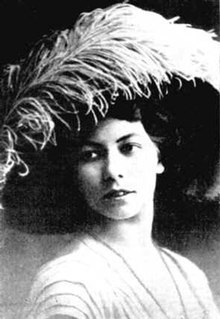
Back برونيسلافا نيجينسكا Arabic برونيسلايڤا نيچينسكا ARZ Браніслава Фамінічна Ніжынская Byelorussian Бронислава Нижинска Bulgarian Bronislava Nižinská Czech Bronislava Nijinska German Μπρονισλάβα Νιζίνσκα Greek Bronislava Nijinska Spanish Bronisława Niżyńska Estonian Bronislava Nijinska Basque
Bronislawa Nijinska | |
|---|---|
| Бронислава Нижинская | |
 | |
| Born | Bronisława Niżyńska January 8, 1891 Minsk, Minsk Governorate, Russian Empire |
| Died | February 21, 1972 (aged 81) Pacific Palisades, California, U.S. |
| Occupation(s) | Ballet dancer, choreographer, ballet teacher |
| Spouses |
|
| Children | 2, including Irina |
| Relatives | Vaslav Nijinsky (brother) Kyra Nijinsky (niece) |
| Awards | National Museum of Dance's Mr. & Mrs. Cornelius Vanderbilt Whitney Hall of Fame, 1994 |
Bronislava Nijinska (/ˌbrɒnɪˈslɑːvə nɪˈ(d)ʒɪnskə/; Polish: Bronisława Niżyńska [brɔɲiˈswava ɲiˈʐɨj̃ska]; Russian: Бронисла́ва Фоми́нична Нижи́нская, romanized: Bronisláva Fomínična Nižínskaja; Belarusian: Браніслава Ніжынская, romanized: Branislava Nižynskaja; January 8, 1891 [O.S. December 27, 1890] – February 21, 1972) was a Russian ballet dancer of Polish origin, and an innovative choreographer. She came of age in a family of traveling, professional dancers.[1]
Her own career began in Saint Petersburg. Soon she joined Ballets Russes which ventured to success in Paris. She met war-time difficulties in Petrograd and revolutionary turbulence in Kiev. In France again, public acclaim for her works came quickly, cresting in the 1920s. She then enjoyed continuing successes in Europe and the Americas. Nijinska played a pioneering role in the broad movement that diverged from 19th-century classical ballet. Her introduction of modern forms, steps, and motion, and a minimalist narrative, prepared the way of future works.[2]
Following serious home training, she entered the state ballet school in the Russian capital at the age of nine. In 1908 she graduated as an 'Artist of the Imperial Theatres'. An early breakthrough came in Paris in 1910 when she became a member of Diaghilev's Ballets Russes. For her dance solo Nijinska created the role of Papillon in Carnaval, a ballet written and designed by Michel Fokine.[3]
She assisted her famous brother Vaslav Nijinsky as he worked up his controversial choreography for L'Après-midi d'un faune, which Ballets Russes premiered in Paris in 1912. Similarly, she aided him in his creation of the 1913 ballet The Rite of Spring.
She developed her own art in Petrograd and Kiev during the Great War, Revolution and Civil War. While performing in theaters, she worked independently to design and stage her first choreographies. Nijinska started a ballet school on progressive lines in Kiev. She published her writing on the art of movement.[4] In 1921 she fled Russian authorities.
Rejoining the Ballets Russes, Diaghilev appointed her the choreographer of the influential ballet company based in France. Nijinska thrived, creating several popular, cutting-edge ballets to contemporary music. In 1923, with a score by Igor Stravinsky she choreographed her iconic work Les noces [The Wedding].[5]
Starting in 1925, with a variety of companies and venues she designed and mounted ballets in Europe and the Americas. Among them were Teatro Colón, Ida Rubinstein, Opéra Russe à Paris, Wassily de Basil, Max Reinhardt, Markova-Dolin, Ballet Polonaise, Ballet Theatre, the Hollywood Bowl, Jacob's Pillow, Serge Denham, Marquis de Cuevas, as well as her own companies.
Due to war in 1939 she relocated from Paris to Los Angeles. Nijinska continued working in choreography and as an artistic director. She taught at her studio. In the 1960s for The Royal Ballet in London, she staged revivals of her Ballets Russes-era creations. Her Early Memoirs, translated into English, was published posthumously.[6]